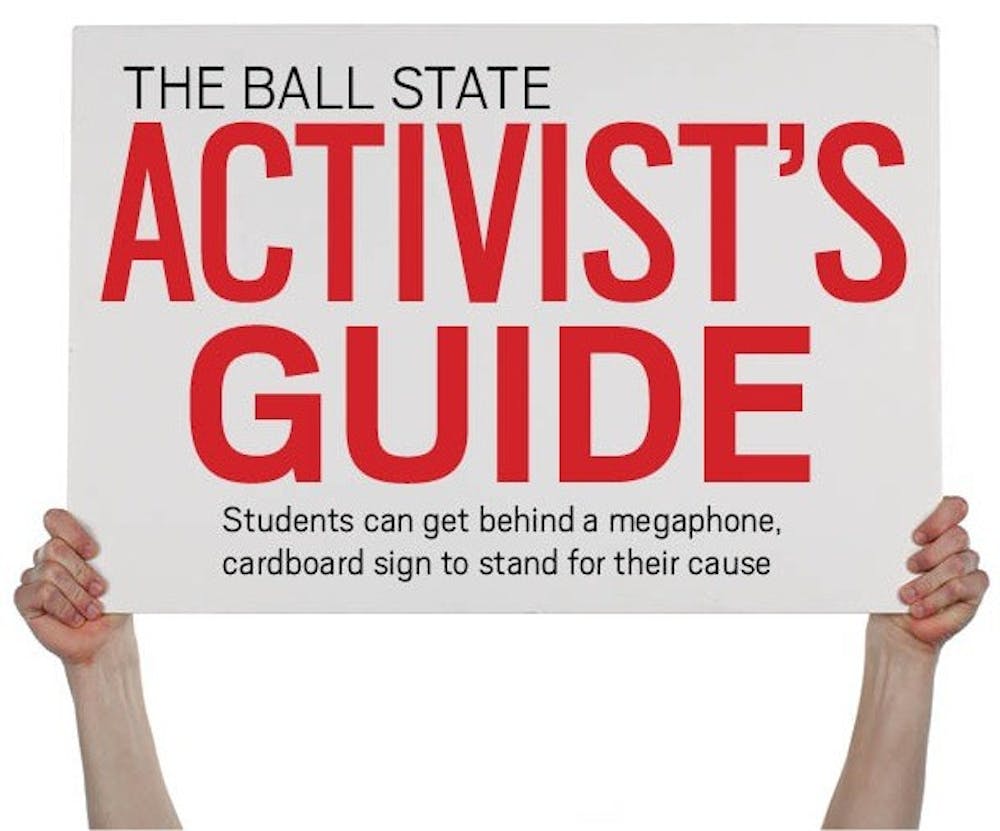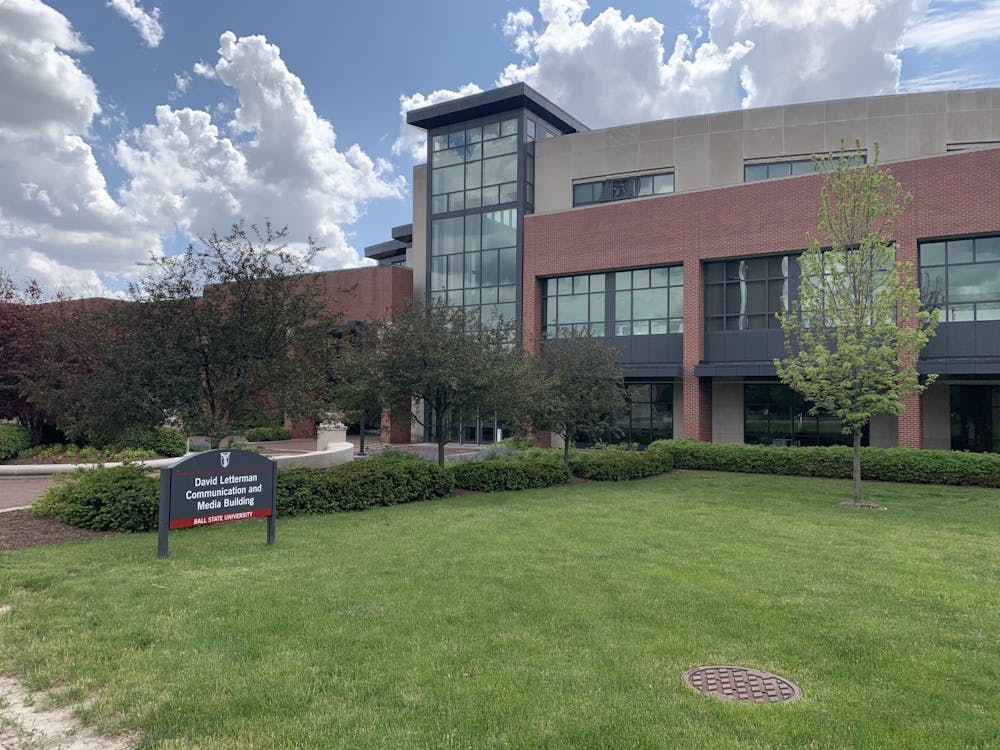Ball State’s protest history
By Anna Ortiz
From the late ‘60s, Ball State’s rabble-rousing history is chronicled in “Ball State University: An Interpretive History” by Anthony Edmonds and Bruce Geelhoed. The Daily News also has recorded its fair share of protests.
April 1969: Four state universities raised tuition from 1969-1970. Ball State’s yearly tuition increased from $340 to $540, and 1,500 students attended a rally to protest the legislature shortfall that led to the tuition raise.
October 1969: The Ball State chapter of the national Vietnam Moratorium Committee formed. The group carried out a ceremony with about 120 people and read the names of soldiers killed in the Vietnam War in front of the Administration Building.
October 1969: During the lead-up to the Vietnam Moratorium, students created a campus-wide underwear raid. The Daily News reported 600 male students participated in a panty raid. As retaliation, 75 women hosted a jock strap raid in the gymnasium and men’s residence halls.
May 1970: This was Ball State’s largest demonstration against the war with several thousand students and faculty. They opposed the military action in Cambodia and the deaths of students at Kent State University during a protest.
May 1970: More than 600 people gathered in front of the Administration Building in reaction to a threat to burn a dog to protest the Vietnam War by the Hoosier Anti-War Coalition. The HAWC rebutted at the protest to say they were not really going to harm a dog — they were trying to create outrage about the “thousands of human beings are being burnt and killed daily in Southeast Asia,” according to one HAWC representative at the scene.
March 1974: Several hundred people streaked on Riverside Avenue over the period of three days. About 2,00 students jammed the avenue and blocked off the street. Some streakers threw rocks and bottles at the police trying to quell the mass streak, which led to the end of the odd demonstration with no clear purpose.
October 2011: Ball State students demonstrate in the Occupy Indianapolis event in Monument Circle in Indianapolis.
March 2012: More than 200 Muncie residents marched through Martin Luther King Jr. Boulevard in Muncie to protest the death of Trayvon Martin.
August 2012: Outside of The Atrium, students gathered to educate people about the Chick-Fil-A controversy and push for its removal from campus. The chain restaurant openly discriminated against the lesbian, gay, bisexual, transgender and queer community.
August 2013: A group of students in orange jumpsuits were mock waterboarded in front of Bracken Library. Amnesty International, a student group, protested on campus against indefinite detention in Guantanamo Bay and for the support of a legislative piece in closing the detainment facility.
October 2013: Missionaries to the Preborn, an anti-abortion organization, protested across campus. The group had to be relocated because of violations in the university’s policy and complaints of “disturbing” images.
SOURCES: The Daily News, “Ball State University: An Interpretive History” by Anthony Edmonds and Bruce Geelhoed
Students have seen their fair share of mock waterboarding, giant posters of mangled fetuses and shouting this semester as protests and demonstrations have landed on campus.
“Having a venue where you can exchange ideas in a respectful and thoughtful manner is really a great thing,” Thomas Gibson, assistant vice president of student affairs, said.
Protesting isn’t simply for activists of decades past or religious groups — any student can be on the other side of the microphone and express their views to the masses.
BE PREPARED
Matt Smith, a senior history and political science major, protested on campus against indefinite detention in Guantanamo Bay and for the support of a legislative piece in closing the detainment facility.
Amnesty International, a student group, took around three months to prepare for the protest. Since the demonstration was scheduled for early in the semester, Smith and a few other students started preparing during the summer.
They gathered materials like the orange jumpsuits they wore during their march from the L.A. Pittenger Student Center to Bracken Library, they researched the legislative piece that they were supporting and planned their demonstration exactly how they had imagined it.
“We had to get materials together and find out exactly how we wanted it to go and how we wanted it to look,” Smith said. “There was a pretty significant amount of planning.”
Many people the protesters talked to didn’t know Guantanamo Bay was a national controversy. When people saw them protesting and doing a mock waterboarding, Smith said they started asking questions and becoming more engaged with the protesters.
“We weren’t standing around complaining about something,” he said. “We were actually getting stuff done.”
KNOW THE RULES
The “Use of Property for Expressive Activities” in the Ball State Student Handbook Appendix N is the activist students’ bible.
The policy is a year old and is still being reworked.
“Since this … policy was developed last year, we really didn’t have a separate policy for it,” Kevin Kenyon, associate vice president of facilities, said Oct. 9. “It was sort of a paragraph in the student rights manual. It was broken out as a policy.”
All demonstrations or protests must be approved in advance, unless it will be outdoors, include no booths or tables and include less than 50 people.
To get a demonstration approved, contact Kenyon, the campus reservationist, at least three days beforehand to be approved.
Students also must fill out the “On-Campus Space Requisition Form” on bsu.edu.
DO’S AND DON’TS
Make sure the demonstration won’t interfere with the flow of students and vehicles trying to get around campus. Additionally, avoid times and places where another campus activity would be disrupted.
To make sure the demonstration won’t break any rules, flip through the student handbook. This includes staying away from obscenity. Megaphones or any amplification device aren’t allowed near classroom areas. Using these devices requires permission.
Also, know your location. Students can do indoors demonstrations in John R. Emens Auditorium, Pruis Hall and the Student Center. Groups of more than 50 can only demonstrate on the Quad, University Green or LaFollette Field, according to Appendix N. The demonstrations must be 60 feet or more away from any window or door of a classroom, office or residence hall.
IT’S WORTH IT
For Smith, being an American citizen brings the responsibility of knowing what is going nationally and globally.
“Students bring a new perspective,” he said. “It is really important, especially for students, to get out there and get their voices heard. If we don’t speak out, then no one else will. This is what our country is about — speaking out about injustices.”





